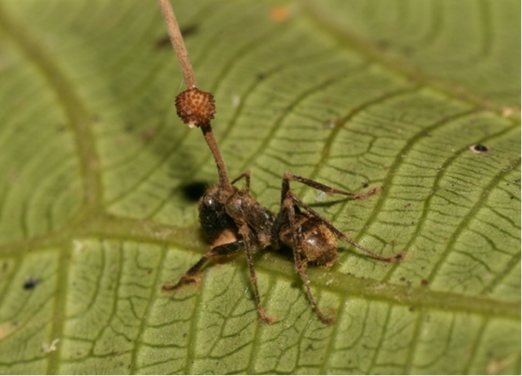|
Who knew that a species of fungi that consumes insects (mainly ants) would be such a hot topic in 2023? Unexpectedly, “The Last of Us”, a post-apocalyptic zombie show based on a popular video game, had everyone talking about Ophiocordyceps unilateralis—zombie-ant fungus. This week, we want to get the facts straight while season two continues development and we reminisce about a brilliant season one! What is an entomopathogenic fungus? Why can’t a species of Ophiocordyceps, or something similar, become a zombie-human fungus? Finally, how does this species manipulate its host in such a frightening way? Read on to find out the less dramatic, but equally fascinating, story about these mind mushing monsters. Could We Be Infected?First things first—quite a few news outlets have written about the feasibility of a Cordyceps outbreak in humans. Vox, Futurism, Sky News, The Washington Post, Vulture, and many more. We’re not here to reinvent the wheel, so if you want to read about the video game-inspired story, the likelihood of Cordyceps species infecting humans, or zombie-themed content… give one of those links a try. It is probably already obvious that the spread of fungal species in a way that HBO or a video game portrays is incredibly improbable. That does not mean that we should not be prepared for pandemics, however (COVID-19 was a great example of that fact). But as fun as it is to think about the feasibility of the zombie apocalypse, we are a bug blog, so we’re going to focus on Ophiocordyceps and the extremely creepy way they manipulate insects to do their bidding. What Are Entomopathogenic Fungi?Simply put, entomopathogenic fungi are fungi that kill or seriously impair insects. They span the entire fungal kingdom and there are multiple ways that these organisms attack and kill insects. Many of the strategies are nightmare-inducing. For instance, one species that attacks cicadas plugs their butts, and scatters spores from the sky as they fly around. “The Last of Us” chronicles the zombie-ant fungus, which controls an ant’s muscles until the ant dies and a fruiting body explodes from its’ head. Some of these pathogens can attack a wide array of insects, and some are very host specific. Some broad-spectrum insect killers, like Beauvaria bassiana have been turned into pesticides. Ophiocordyceps, the pathogen we’re talking about in this blog, is host-specific. Each species of Ophiocordyceps attacks a specific insect species. Ophiocordyceps Ophiocordyceps, the group of fungi that inspired the latest zombie phenomenon, contain over 100 species that attack insects like moths, butterflies, and beetles. At least 35 species within the group are capable of performing some sort of “mind control” on the host. According to experts, there may be as many as 600 species in this group waiting to be described. Each species is matched to its specific insect host. For example, Ophiocordyceps odonatae attacks dragonflies (Order: Odonata). How Do They Work? Let’s focus on Ophiocordyceps unilateralis for this part, the zombie-ant fungus. The life cycle of this fungal species can be described in four parts: infection, death grip, stalk growth, and dispersal. Spores (the infectious part) of this species targets a type of carpenter ant (Camponotus leonardi). Spores attach to the cuticle (skin) of a passing ant and begin to secrete digestive enzymes that start eating away at the ant’s body so that they can enter the host. Then, yeast-like growth begins inside. This eventually causes the ant to fall from the tree canopy to a lower height that is more optimal for fungal growth. To control movement, the fungus controls ant muscles (so, not technically the ant’s mind like a true ‘zombie’) and prompts the ant to crawl up to a leaf. Then, the ant bites the leaf with a death-grip that keeps it from falling. Once the ant dies, a stalk grows from the base of the neck and exits the head. Spores release, a new ant is infected, and the cycle begins again. Interestingly, healthy ants in a colony can tell when a fellow worker is infected and they will carry the diseased far away to protect the whole. ConclusionsMycologists (folks that study fungi) agree that the chance of an Ophiocordyceps species transition from insects to humans is non-existent. These scary little pathogens are extremely host-specific—they simply don’t have the machinery to survive in people and the leaps that would need to occur for them to adapt to us are just too great. These pathogens, although frightening to watch, keep insect numbers in check and contribute to ecosystem balance. Unfortunately, their only function, maintain natural order, is much less ‘sexy’ than the chaos zombie thrillers want you to think that they can cause. So, for now, rest easy. Bug-killing fungi should only haunt the dreams of insects!
0 Comments
Your comment will be posted after it is approved.
Leave a Reply. |
Bug Lessons BlogWelcome science communicators and bug nerds!
Interested in being a guest blogger?
Archives
November 2023
Categories
All
|
